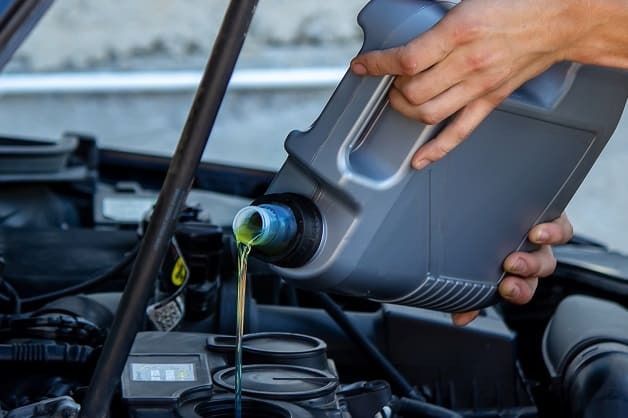
 Data Structure
Data Structure Networking
Networking RDBMS
RDBMS Operating System
Operating System Java
Java MS Excel
MS Excel iOS
iOS HTML
HTML CSS
CSS Android
Android Python
Python C Programming
C Programming C++
C++ C#
C# MongoDB
MongoDB MySQL
MySQL Javascript
Javascript PHP
PHP
- Selected Reading
- UPSC IAS Exams Notes
- Developer's Best Practices
- Questions and Answers
- Effective Resume Writing
- HR Interview Questions
- Computer Glossary
- Who is Who
What is the full form of EOT?
Introduction
Engine Oil Temperature (EOT) means the temperature of the engine oil in a vehicle's engine. Engine oil plays a crucial part in lubricating engine components, decreasing friction, and dispersing heat developed during engine operation. The temperature of the engine oil is an indispensable parameter to scrutinise as it can influence the engine's performance and longevity.

If the oil temperature is too ignoble, it may not deliver adequate lubrication, generating advanced friction and wear on engine parts. Contrarily, if the oil temperature is too increased, it may break down and forfeit its lubricating possessions, inducing damage to the engine.
Definition of EOT
EOT is defined as the temperature of the engine oil in a vehicle's engine. The engine oil temperature is a critical parameter to scrutinise as it can simulate the engine's performance and longevity. It is usually calculated in degrees Celsius (°C) or Fahrenheit (°F) using sensors discovered in the engine oil pan or other components of the engine. The EOT reading is utilised by the engine control module (ECM) or powertrain control module (PCM) to modify the engine's operating parameters and confirm that the oil temperature remains within the suitable range.
Importance of EOT Measurement
The stature of EOT (Engine Oil Temperature) is essential for several justifications, including:
Lubrication and Cooling The engine oil temperature impacts the lubricating properties of the oil. If the oil temperature is too low, it may not deliver sufficient lubrication, which can induce improved friction and wear on engine components. On the other hand, if the oil temperature is too much, it can break down and forfeit its lubricating effects, rendering engine impairment. Therefore, scrutinising and preserving the correct oil temperature is significant for optimal lubrication and cooling of engine elements.
Engine Performance The oil temperature can impact engine performance, as the thickness of the oil differs with temperature. If the oil temperature is too high or too low, it can influence the engine's capacity to initiate, idle, and accelerate correctly. Scrutinizing and regulating the oil temperature can assist and confirm that the engine functions efficiently and optimally.
Longevity of Engine Keeping the correct oil temperature can help extend the life of the engine by decreasing the wear and tear on engine elements. Overheating of the engine due to high oil temperature can cause harm to internal engine elements, such as pertinence and pistons, leading to costly repairs or engine loss.
Fuel Efficiency The oil temperature can also impact fuel efficiency, as a cold engine takes a more extended time to warm up and achieve optimal operating temperature, which can raise fuel consumption. Scrutinizing and managing the oil temperature can help guarantee that the engine functions at the most efficient temperature scope, thereby enhancing fuel efficiency.
Factors Affecting EOT
Several aspects can impact the Engine Oil Temperature (EOT) in a vehicle's machine. Some of the preliminary elements include:
Ambient Temperature The ambient temperature or outside temperature can greatly impact the engine oil temperature. In cold weather states, the oil takes an extended time to warm up, and in hot weather, the oil can heat up fast, directing to augmented engine oil temperature.
Engine Load The engine load or the portion of the power needed from the engine can simulate the EOT. High engine packs, such as towing or climbing hills, can compel the engine to function harder, rendering more heat and improving the EOT.
Engine Speed The engine speed or RPM can also influence the EOT. More increased engine speeds cause more heat, raising the EOT.
Coolant Temperature The coolant temperature can indirectly influence the EOT. The coolant aids handle the engine's temperature, and if the coolant temperature is too high, it can generate the engine oil temperature to increase.
Type of Oil The type of oil utilised in the engine can also impact the EOT. Various oils have additional temperature ranges, and utilising oil that is not appropriate for the engine can usher in expanded oil temperature.
EOT Measurement Techniques
There are several strategies for estimating the Engine Oil Temperature (EOT) in a vehicle's motor. The most common procedures include:
Dipstick Method The dipstick technique implicates using a dipstick with a temperature gauge or a thermometer connected to it. The dipstick is inserted into the engine oil and the temperature gauge or thermometer delivers a reading of the EOT.
Infrared Technique The infrared process affects utilising an infrared thermometer to estimate the EOT. The thermometer is indicated at the engine oil pan or other aspects of the engine, and it delivers a reading of the EOT.

Sensor Process Most contemporary motor cars have sensors that are nestled in the engine oil pan or different components of the engine to estimate the EOT. The sensors communicate the temperature reading to the engine control module (ECM) or powertrain control module (PCM), which then modifies the engine's operating parameters to preserve the correct oil temperature.
OBD-II Scanner Method OBD-II scanners can also be utilised to read the EOT. The scanner is packed into the OBD-II port of the automobile, and it supplies a reading of the EOT, along with other diagnostic knowledge.
Conclusion
The Engine Oil Temperature (EOT) is a crucial parameter to observe in a vehicle's engine. The EOT simulates the engine's lubrication, cooling, implementation, longevity, and fuel efficiency, making it substantial to preserve the proper oil temperature range.
While several factors like ambient temperature, engine load, engine speed, coolant temperature, kind of oil utilised, and oil level, can simulate the EOT, various techniques are known to evaluate the EOT. Periodic monitoring and supervision of the EOT can help avert expensive repairs, enhance engine implementation, and extend the engine's life.
FAQs
Q1. What is the highest temperature for engine oil?
Ans: Quality customary motor oil will take oil sump temperatures up to 250 degrees, but begins breaking down over 275 degrees.
Q2. What temperature is too freezing for engine oil?
Ans: Minus 20 degrees C or beyond is too freezing for engine oil.
Q3. What temperature does car oil coagulate?
Ans: At 20 degrees Fahrenheit, most oils have the consistency of maple syrup.

